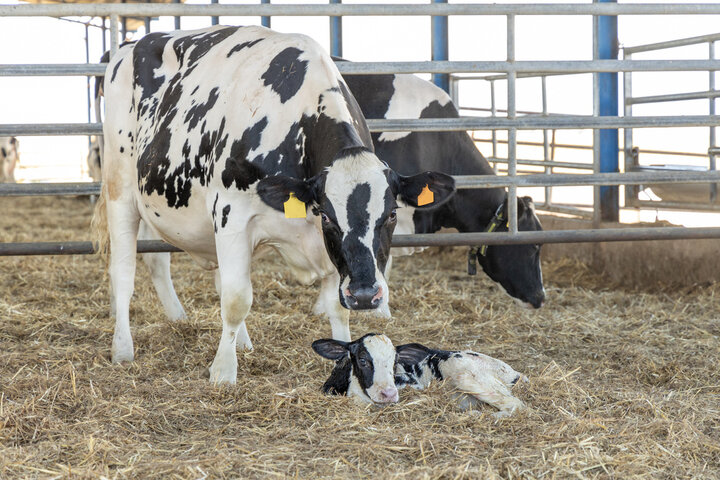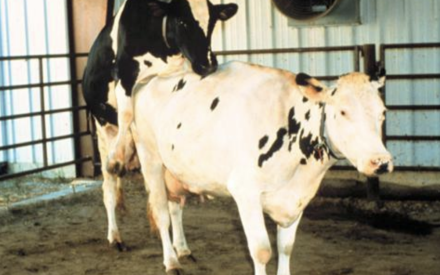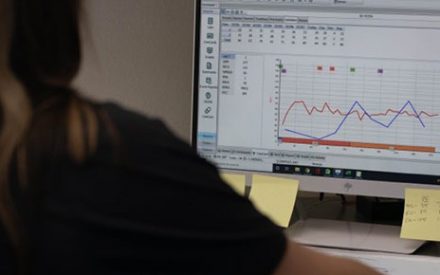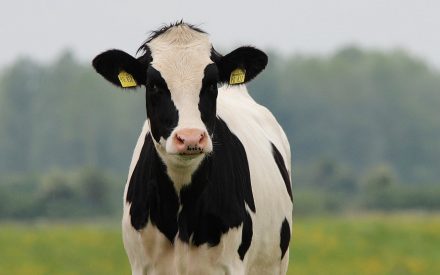Advances in activity monitoring technology have taken electronic estrus (heat) detection from concept to reality on more dairy farms today. This is of significance because estrus detection has historically been a challenging task.

Just a few of the reasons why include:
- Decreased estrus expression and duration in lactating dairy cows
- The need for trained labor and time
- Confinement housing and concrete flooring
- Delayed return to cycling postpartum
Now that time and experience have allowed for more research with these systems, what are some considerations for making them a success for reproductive management?
Have a plan in place to inseminate cows not detected in estrus
Early research on accelerometer-based systems for activity monitoring found that they identified around 70% of cows in estrus for their first artificial insemination (AI) after calving (Valenza et al. 2012; Fricke et al 0.2012). This means you must have a plan in place to identify the roughly 30% of cows not detected in estrus and intervene with a timed AI (TAI) program. A bonus of pairing TAI and activity monitoring together is that the activity monitoring system can help identify anovular (non-cycling) cows. This helps management measure if their percentage of anovular cows is above benchmarks or not, and more importantly treat anovualar cows with a fertility program before their first AI (Double Ovsycnh; CIDR-synch).
Activity monitoring systems will not eliminate the use of TAI programs on your farm, but they will change the frequency and specific cows you will be using them on. That said, variation exists from farm to farm in the actual percent of cow’s activity monitoring systems will identify in estrus (Burnett et al. 2017). This leads us to our next key:
Herd health and management affect their success
A Canadian research project (LeRoy et al. 2018) found 83% of cows in estrus by 80 days in milk using activity monitoring systems. While 83% is higher than many other studies, what is really interesting is that they were able to identify sub-populations that had poorer estrus detection rates. For example, cows with a purulent vaginal discharge five weeks post calving had 68% identified in estrus, and those with a combination of low body condition score (BCS, ≤2.5) and lameness at week seven postpartum had only 53% identified in estrus.
In a related study (Bruinje et al. 2023), cows with either a ≥0.5 loss in BCS, retained placenta, endometritis, or purulent vaginal discharge had lower rates detected in estrus by activity monitoring systems than unaffected cows. In addition, there was a tendency (P=0.06) for cows with lameness to have lower rates detected in estrus. Parity has also emerged as a factor, with first lactation cows having greater detection rates using activity monitoring systems than older cows (Burnett et al. 2017; Bruinjé et al. 2023).
While these systems can help management, they alone are not a band-aid for management challenges. Herdsmanship skills are still needed to be on top of cow health and lameness to optimize the effectiveness of activity monitoring technology for estrus detection.
Consider twice daily AI to optimize fertility
Early research in Wisconsin (Valenza et al. 2012) found a mean interval from AI to ovulation of 7.9 hours, which is within the guidelines for AI timing. That study also found, though, that 21% of cows may have received AI too late, between 0 and 12 hours after ovulation. Later research (LeRoy et al. 2018) didn’t find an effect of AI timing in second and greater-lactation cows but did see an effect in first lactation cows. Fertility in first-lactation cows was greater if it occurred 0 to 8 hours after the alert from the system versus AI occurring later at either 8 to 16 hours or 16 to 24 hours later.
Incorporating twice dairy AI into your management can benefit fertility by ensuring more cows receive AI in a timely manner after reaching the activity threshold set in the system.
Activity monitoring systems are a useful tool to identify and re-inseminate open cows for second and greater AI
Ultimately, decisions to utilize TAI or an activity monitoring system come down to tradeoffs between the fertility advantage of using Double Ovsynch for first postpartum TAI, and potential improved service rates utilizing activity monitoring systems for estrus detection. Economic modeling has shown it may be a draw between the two approaches if conception rates to estrus detection are acceptable, above 30-35% (Giordano et al. 2012). When conception rates are less than that, TAI programs have the advantage.
Where the two approaches can complement each other, rather than be exclusive, is using Double Ovsynch for first postpartum TAI followed by electronic estrus detection for second or greater AI. This will optimize your AI service rate by inseminating repeat breeders based upon activity 18-25 days after AI, without having to wait for a non-pregnancy diagnosis to do so. With 100% TAI, our best strategy is often to wait until day 32 after AI to administer the first GnRH of Ovsynch and conduct pregnancy diagnosis. That ultimately means an interval of 42 days between AIs.
More information
For more information on using accelerometers for estrus detection, please see Dr. Fricke’s paper Expression and detection of estrus in dairy cows: The role of activity monitoring systems (Animal, 8(s1), 134-143).
Table of Contents
- Have a plan in place to inseminate cows not detected in estrus
- Herd health and management affect their success
- Consider twice daily AI to optimize fertility
- Activity monitoring systems are a useful tool to identify and re-inseminate open cows for second and greater AI
- More information
- Reviewed by
- References
Reviewed by
Dr. Paul Fricke, Professor & Extension Specialist, Dairy Cattle Reproduction, University of Wisconsin-Madison Division of Extension (Spring 2024)
References
Bruinjé, T. C., Morrison, E. I., Ribeiro, E. S., Renaud, D. L., Serrenho, R. C., & LeBlanc, S. J. (2023). Postpartum health is associated with detection of estrus by activity monitors and reproductive performance in dairy cows. Journal of Dairy Science, 106(12), 9451-9473.
Burnett, T. A., Madureira, A. M., Silper, B. F., Fernandes, A. C. C., & Cerri, R. L. (2017). Integrating an automated activity monitor into an artificial insemination program and the associated risk factors affecting reproductive performance of dairy cows. Journal of Dairy Science, 100(6), 5005-5018.
Fricke, P. M., Carvalho, P. D., Giordano, J. O., Valenza, A., Lopes, G., & Amundson, M. C. (2014). Expression and detection of estrus in dairy cows: the role of new technologies. Animal, 8(s1), 134-143.
Giordano, J. O., Kalantari, A. S., Fricke, P. M., Wiltbank, M. C., & Cabrera, V. E. (2012). A daily herd Markov-chain model to study the reproductive and economic impact of reproductive programs combining timed artificial insemination and estrus detection. Journal of Dairy Science, 95(9), 5442-5460.
LeRoy, C. N. S., Walton, J. S., & LeBlanc, S. J. (2018). Estrous detection intensity and accuracy and optimal timing of insemination with automated activity monitors for dairy cows. Journal of Dairy Science, 101(2), 1638-1647.
Valenza, A., Giordano, J. O., Lopes Jr, G., Vincenti, L., Amundson, M. C., & Fricke, P. M. (2012). Assessment of an accelerometer system for detection of estrus and for treatment with GnRH at the time of insemination in lactating dairy cows. Journal of Dairy Science, 95, 7115-7127.


 ▶️ Watch: Strategies for improving reproduction in dairy herds
▶️ Watch: Strategies for improving reproduction in dairy herds Estrus detection & Estrus detection aids
Estrus detection & Estrus detection aids Cow fertility in the post-genomic era: progress, challenges, and perspectives
Cow fertility in the post-genomic era: progress, challenges, and perspectives Optimizing use of sexed semen in dairy herds
Optimizing use of sexed semen in dairy herds


